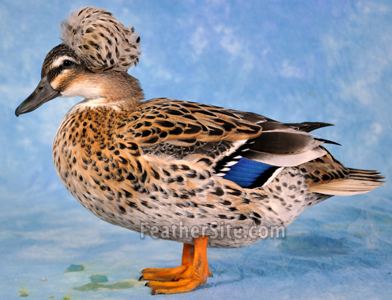APA medium Rank Breed | PCGB light | |
 | ||
Standard Poultry Club of Great Britain Weight Male: Standard: 3.2 kgMiniature: 1.125 kgFemale: Standard: 2.7 kgMiniature: 0.9 kg Scientific name Anas platyrhynchos domesticus Similar Polish chicken, Call duck, Frizzle, Indian Runner duck, Khaki Campbell | ||
The Crested is a breed of domestic duck. It was probably brought to Europe from the East Indies by Dutch ships.:413 It has its appearance because it is heterozygous for a genetic mutation causing a deformity of the skull.
Contents

History

The Crested probably originates in the East Indies, with subsequent development in Holland.:413 Crested ducks are seen in seventeenth-century paintings such as those of Melchior d'Hondecoeter and Jan Steen. Paintings as old as 2000 years have depicted images of a bird, resembling a duck with an assortment of feathers on top of its skull. In the United States the breed was described by D.J. Browne in 1853.:413:197 The white Crested was added to the American Standard of Perfection in 1874; the black variant was added in 1977. The Crested was recognised in the United Kingdom in 1910.:413 In the UK, as in several other European countries, any colour is permitted.
The crest is large and well centered on top of the skull. They have long, slightly arched necks, medium length body, lots of depth and fullness through the breast.
A bantam version of the breed, the Crested Miniature, was bred by John Hall and Roy Sutcliffe in the United Kingdom in the late twentieth century; it was recognised in 1997.:415 The crested gene is very popular in Europe, resulting in crested versions of most breeds. Though Cresteds can be good layers and strong roasting qualities, the main interest and demand for the breed is as pets and decorations. They are not a popular show breed due to challenges associated with the crest.
Breeding
When two ducks heterozygous for the crested allele breed, their offspring are in the usual 1:2:1 ratio:
The offspring of a duck with a crest and a duck with no crest are expected to be 50% with and 50% without a crest.
